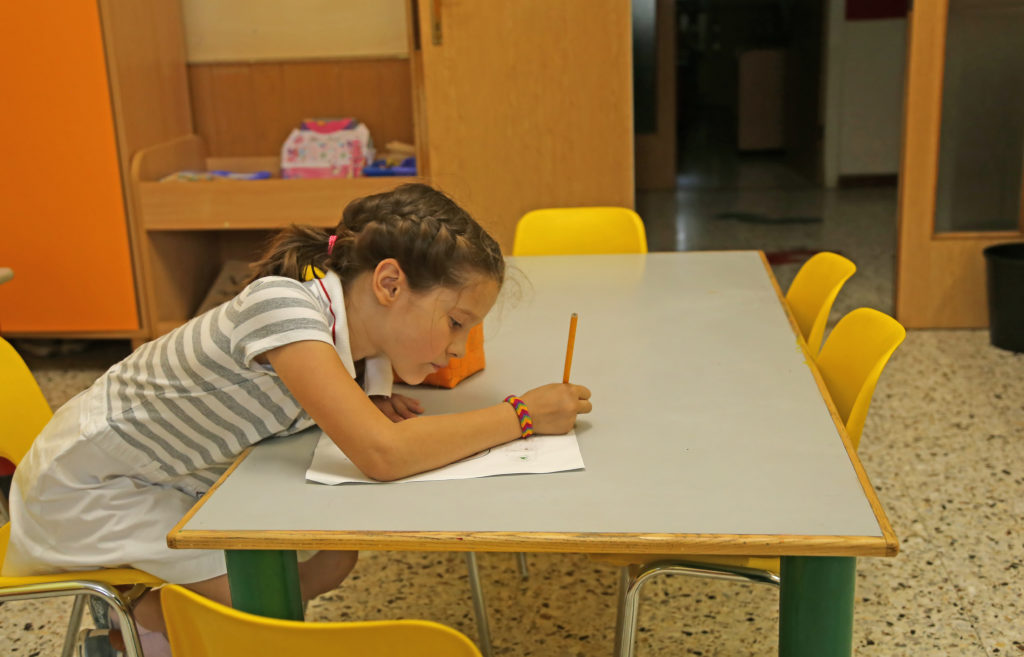In Paris, parents are demonstrating in the face of persistent difficulties that compromise their children’s access to quality education: increasingly frequent class closures, unreplaced absences and a general deterioration in teaching. At the same time, more and more teachers are leaving the profession due to low pay, deteriorated working conditions and lack of institutional support. France is facing an education crisis that requires stronger measures to be put in place compared to the ones the government is implementing.
Paris parents protest against declining quality in public schools
The Vertus primary school, at the edge of the central Le Marais district (between the 3rd and 4th arrondissements) in Paris, has recently been plastered with protest posters and it is not the only one (Verdu, 2025). At the Compans primary school, in the 19th arrondissement of Paris, the parents of the CM1/CM2-C class (the last two years of primary school before moving on to secondary school) also decided to take action (Benmouffok, 2025).
Since the start of the school year in September, their children have been facing chronic disorganisation. The facts are damning: more than twelve days of school without a teacher, a succession of five substitutes making it impossible to maintain consistent educational progress, a lack of assessments and reports for the first semester, and above all, growing anxiety among students who, for some, are about to enter secondary school (Benmouffok, 2025).
Demographic decline leads to teacher cuts
Demographic and urban reasons are causing the public dismantling of the education system and are opening more and more space to the private education model. Central Paris, like many other large cities, suffers from the erosion caused by tourism, gentrification, and a social fabric increasingly made up of residents in transit, the so-called expatriates: managers and senior employees who regularly change international destinations.
The demographic decline that the capital is undergoing is huge. In 2023, 21,700 births were registered in Paris, 10,000 fewer than in 2010. This decline is reflected in educational centres years later and mainly affects public education (Verdu, 2025).
Parisian schools have experienced nearly a quarter drop in their first-year primary students since 2016, while private, state-subsidised schools have seen only a 4.5 percent decrease. Parisian public schools have lost 33,689 students since 2010. For the start of the 2025 school year, forecasts indicate a reduction of 3,200 students.
It was promised to maintain a ratio of 20 students per class (the European average is 19), but the numbers are not increasing. On the contrary, Paris is facing a demographic decline of 3 percent this year [around 1,500 students] (Verdu, 2025).
Consequently, this demographic decline is producing a national cut on the teachers’ positions. Despite the education budget still being the largest item in the national accounts (€88.6 billion), next September, 470 teacher positions at the national level in primary education are expected to be cut, with 110 of those falling in Paris, and a significant portion, in its centre (Verdu, 2025).
Teacher resignations on the rise
What French students are experiencing is the result of a deeper crisis in the education system which has an obvious cause: the national education system can no longer recruit. Teacher exams are seeing a haemorrhage of candidates, vocations are collapsing, and posts are no longer being filled. Year after year, the teaching profession is devalued, working conditions deteriorate, salaries remain insufficient compared to the responsibilities, and teachers themselves suffer from a lack of institutional support (Benmouffok, 2025).
French public school teachers are quitting their jobs at a concerning rate. In just a decade, from 2012 to 2022, the number of departures quadrupled. While the number of resignations is still relatively moderate compared to the total number of teachers in France, the exponential growth in the number of teachers quitting is worrying (FirstPost, 2024).
The French public education system, which serves 80 percent of the country’s students, is facing significant staffing shortages. As of July, 3,185 teaching positions remained unfilled for the 2024-2025 school year. The previous school year (2023-2024) alone saw 15 million teaching hours lost due to absent teachers (FirstPost, 2024).
Moreover, French teachers’ salaries regularly fall below the average of the Organisation for Economic Cooperation and Development (OECD), comprised of 38 countries. This is happening despite the French government spending more per student than other OECD countries. Low pay is exacerbated by long hours and one of the worst pupil-teacher ratios in Europe. Many teachers also face the added burden of performing administrative tasks in large classrooms, often with more than 30 students (FirstPost, 2024).
Children are paying the consequences of the education crisis
Children are the direct victims of this crisis. They see their learning days replaced by makeshift daycare hours, tossed between various substitutes or spread across already overcrowded classes (Benmouffok, 2025). The quality of education is deeply affected and produces consequences like anxiety in students who have no control over a situation which is seriously affecting their development and well-being.

“In the centre, we are asked to eliminate 15 teacher positions, which translates into 15 classes. The first consequence of the closure will be an increase in the number of students per classroom and a deterioration in their comfort. We have students with disabilities, and that also requires space and resources to cater to them. My prediction is that if the class threatened with closure is shut, we will have classrooms with up to 30 students.”
– Laura Gédin, headteacher of the Vertus school in Paris (Verdu, 2025).
In this context, children with disabilities will pay the highest cost. As the number of children per class increases, the less space they will have for a personalised curriculum according to their needs. Moreover, if the number of teachers is cut, specialised teachers for children with disabilities will be the first to be reduced as well as the funds dedicated to teachers’ training.
Multi-level classes: an intermediate option to avoid the elimination of classes
This model consists of putting together students of different levels, namely two or more levels. It can be managed with 20 or 22 students per class. While the teacher teaches some students, others work independently. The double level is already a very widespread reality in Paris. Schools like Saint Martin or Turenne, in the 3rd district, are once again targets for these reductions. At Vertus, if the threatened closure happens, there will no longer be any single-level classes.
“This model (…) can have positive aspects, but if it happens, as would be the case here [at the Vertus school], where we reach a triple level, it becomes very difficult. In rural areas, there are mixed-grade classes, of course, but teachers are trained for this type of education. It doesn’t exist in Paris. The double level can be interesting, but only if the teacher has chosen it and has students capable of doing so. If classes close, they will not reopen. And people will leave more and more. Or they will switch to private schools, as is already happening.”
– Laura Gédin, headteacher of the Vertus school in Paris (Verdu, 2025).
The rise of private schools
As state schools slowly disintegrate, more prosperous families are turning to private education (Diallo, 2023). The proportion of sixth-grade students (the year before high school) enrolled in private, state-funded education, which does not suffer from budget restrictions, has increased significantly since 2020: from 35 percent to 38.6 percent in three years and it had remained relatively stable since 2005. More than half of the students entering pre-high school (around age 14) in Paris will be enrolled in private, state-subsidised schools within the next ten years (Verdu, 2025).
This trend would exacerbate the social divide between public and private education. In 2023, 55 percent of sixth-grade students from very privileged social classes were already in private, state-subsidised schools. By 2034, they would account for 7 percent, representing almost 90 percent of private school sixth graders. On the other hand, only between 6 and 7 percent of disadvantaged students would be enrolled in this sector, the same proportion as currently (Verdu, 2025).
“In Paris, for the past three years, only public schools have been closing. In contrast, private schools maintain stable funding and staffing. This creates a two-speed education system: public for working-class areas, and private for middle and upper-class students and the good students. It is socio-educational segregation. There is no justification for this. If private schools weren’t so heavily subsidised, all their students could be accommodated in public schools.”
– Martin Raffet, president of the Federation of Parent Associations (Verdu, 2025).
The five best middle schools (collèges) in Paris are private. Yet fee-paying schools also receive public funding, raising questions about the national investment in children who need it the most. These private institutions carry out social and educational selection, shifting the biggest challenges onto the public sector (Diallo, 2023).
Promoting equality through quality education
The French education system is among the most unequal in the developed world. It fails to address existing social inequalities and, in some cases, even contributes to exacerbating them. Students from disadvantaged backgrounds are further weakened by this system. Learning becomes an increasingly difficult task, particularly for students from modest backgrounds, among whom one in ten is affected by extreme poverty (Guéchi, 2023).
In 2018, Fabien Gay, a senator for Seine-Saint-Denis to the north-east of Paris – the poorest region in France, with the highest concentration of immigrants – cited evidence to parliament of what he said amounted to a policy of “geographical discrimination on the part of the state”. He highlighted the fact that teaching vacancies in the area were less likely to be filled than those anywhere else in the country. The teacher shortage means every pupil in the area, over the course of their schooling, loses the equivalent of a full year’s teaching (Diallo, 2023).
The state spends less on the average student in Seine-Saint-Denis than on their counterparts in other parts of the capital. This unfairness perpetuates a cycle of disadvantage. Such districts gain a reputation for being “difficult”, so they can only attract teachers who are relatively young, inexperienced, and at the lower end of the pay scale. More experienced teachers head for higher-profile schools in the richer parts of the capital as soon as they can. The net effect is that the poorest students, often from immigrant families, always bear the brunt of the sector’s shortcomings (Diallo, 2023).
French schools perpetuate social inequality, hindering the most disadvantaged students from escaping the unfair circumstances in which many grow up. Bullying, meanwhile, is rampant in many schools and is blamed for the two cases a month of schoolchildren taking their own lives (Diallo, 2023).
What the government must do next
The Ministry of Education justifies its measures in terms of cuts by a strong decrease in the number of students, of around 80,800 in public primary education. According to a spokesperson for the Ministry of Education, the initial forecast was to close 4,000 positions. The criteria for closing classes were not fixed at a national level, but the Ministry of Education conducted a detailed analysis at the local level which took into consideration the evolution of the number of students enrolled, the student’s progress and the diversity of schools (Verdu, 2025).
In an attempt to address the shortages, the government launched a scheme in 2022 to hire contract teachers on short-term contracts. However, many of these contract teachers left the profession shortly after starting, especially given the fact that they often didn’t have any prior teaching experience or sufficient training. This has left public schools heavily dependent on young, inexperienced teachers, many of whom struggle with the challenging conditions and low pay (FirstPost, 2024).
While the mobilisation of parents is encouraging, it must now be matched by concrete and immediate action: appointing a permanent teacher for the class until the end of the year, implementing a catch-up learning plan, and making firm commitments to train and recruit enough teachers, ensure dignified learning conditions, and develop a long-term national education strategy (Benmouffok, 2025).

We at Humanium strongly believe in the importance of quality education for all. In this sense, sharing challenges across countries in the field of children’s access to education is part of our mission to call governments to play their role in adopting new strategies that provide more investments in education as we call citizens to join us in advocating for equitable access to education. Join Humanium by sponsoring a child, making a donation, or becoming a member or a volunteer!
Written by Arianna Braga
References:
Benmouffok, S. (2025). Le combat d’une école parisienne, symptôme d’une crise nationale. Retrieved from Le Nouvel Obs at https://www.nouvelobs.com/societe/20250307.OBS101173/le-combat-d-une-ecole-parisienne-symptome-d-une-crise-nationale.html, accessed on 29 March 2025.
Diallo R. (2023). France’s schools are in crisis – and it has nothing to do with pupils’ dress. Retrieved from The Guardian at https://www.theguardian.com/commentisfree/2023/sep/20/frances-schools-are-in-crisis-and-it-has-nothing-to-do-with-pupils-dress, accessed on 29 March 2025.
FirstPost (2024). Public education crisis in France: Why are teachers increasingly quitting their jobs? Retrieved from FirstPost at https://www.firstpost.com/world/public-education-crisis-in-france-why-are-teachers-increasingly-quitting-their-jobs-13815302.html, accessed on 29 March 2025.
Guéchi, Y. (2023). Pression sur les élèves : un constat de crise du système éducatif français. Retrived from Le Grand Soir at https://www.legrandsoir.info/pression-sur-les-eleves-un-constat-de-crise-du-systeme-educatif-francais.html, accessed on 29 March 2025.
Verdu, d. (2025). Aulas llenas con alumnos de cursos diferentes: el ‘efecto Airbnb’ y la caída demográfica precarizan las escuelas del centro de París. Retrieved from El País at https://elpais.com/educacion/2025-03-19/aulas-llenas-con-alumnos-de-cursos-diferentes-el-efecto-airbnb-y-la-caida-demografica-precarizan-las-escuelas-del-centro-de-paris.html, accessed on 29 March 2025.


